Better waste tank monitoring with Maretron

Have Another Day’s waste tank monitors have never been very accurate and that’s only gotten worse as time has gone by. In well over 10,000 nautical miles of cruising we’ve only overflowed a waste tank once, but that’s once too many. So, when the gauges on both tanks recently seemed to completely stop working, I decided it was time to find a new solution.

When Carver built Have Another Day she was equipped with TankWatch 4 monitors on both 50 gallon waste tanks. The four lights on the display show you if the tanks are empty, low, half-full or full. Over time the gauges have malfunctioned in several ways: multiple lights lit at the same time, one or more steps skipped, or not resetting to empty after a pump-out.
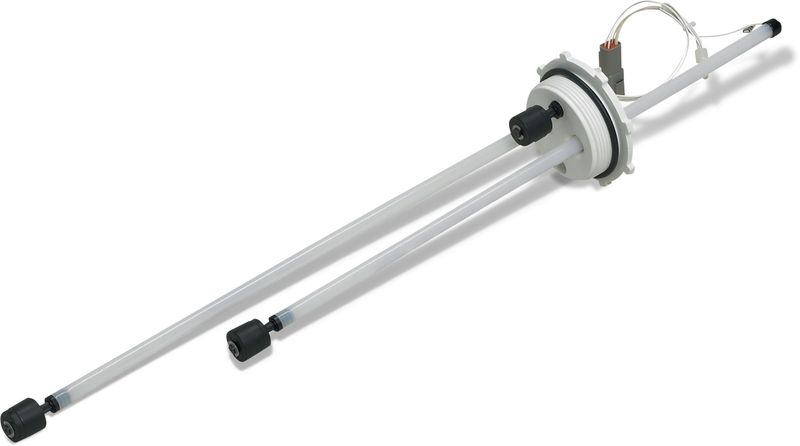
All the products in Dometic’s TankWatch line rely upon small float switches suspended in the waste tank, and they’re prone to buildup and fouling from the contents of the tank. I’ve had mine out a few times to clean them — no fun! The most recent attempt at cleaning netted only marginal improvement, further indicating this system was in need of replacement.
I could have replaced just the TankWatch senders, which are still easily available from Dometic. But, I wanted something with fewer moving parts and hopefully more granular information than the four lights provided by my TankWatch monitor.
In consultation with Maretron, we decided that a FPM100 paired with submersible pressure transducers would be the best fit for my boat. With a total of six possible tanks to monitor — two black water, two fresh water, and two fuel — the six channel FPM100 was a pretty obvious fit. The FPM100 can be used to monitor any combination of six tank sensors or pressure transducers.
Maretron has a helpful knowledgebase article that guides you through selecting the tank monitoring product that best fits your boat. The FPM100 has a list price of $395, but I think the logical way to calculate the price is per tank monitored and at roughly $65 per tank this seems like a very solid value. Because the FPM can be used for either tank level or pressure measurement you could use additional channels for other purposes if you don’t have six tanks to monitor.
The submersible pressure transducers have a list price of $250, but if your tank has bottom access — like for a site tube — you can use their screw in pressure transducers that list for $150. Maretron says they’ve found the submersible pressure transducer the best fit for waste tanks versus ultrasonic, floats or other technologies.

My waste tanks are about 32 inches tall so the 0 to 1.5 PSI sensor was an easy call. It will support up to 41.5 inches of water so it would comfortably measure my tanks. My fuel tanks are over 40 inches tall and I think I would move up to the next pressure range to ensure measurement over the entire range of the tank.
The sensor comes with a plate designed to fit a standard 5 bolt sending unit cut out. However, the TankWatch senders use a 3 inch threaded fitting to mount into the tank and my tanks didn’t have a 5 bolt cut-out in them. I really didn’t want to put any new holes in my waste tanks, so fortunately I found inspection port caps that mate to the fitting in the top of the tank. I used a 1.5-inch hole-saw to drill into the cap and then secured the plate and cable gland to the cap.
The rest of the physical installation consisted of simply removing the old (unpleasant) senders and cleaning up the area. Once that was complete all I had to do was make sure there was sufficient cable below the gland to allow the sensor to lay on the bottom like Maretron’s diagram shows above.
With the physical install out of the way — and my hands washed several times, even though gloves were used — it was time to configure my system, which requires a Maretron DSM display or gateway. I used a USB100 USB to NMEA 2000 gateway connected to my Windows 10 PC running Maretron’s N2KAnalyzer. In the device’s configuration screen, you set up the FPM100 on a channel-by-channel basis, each of which can monitor pressure or tank level. The channel then needs to be configured with the pressure range of the transducer connected. Lastly, fluid type (water, diesel, etc. because they different densities and hence different pressures at depth), tank type (fuel, fresh water, gray water, black water, etc) and tank instance number.
Also, each channel can be labeled with a more detailed description of what’s being monitored. After specifying a label, it will be displayed by all Maretron devices and software on the network.
Once that was done I filled each holding tank to the highest point I would ever want them to reach. That’s just below the spot where the Dometic (formerly Sealand) vacuflush VG-2 vacuum generator dumps into the tank and the vent filter comes out; so if the level is any higher, things get messy. I suspect that the 50 gallon rating of the tank is based on its total dimensions and the reality is less with the way the hoses are mounted. I don’t think this few gallon difference will change much and that using the more precise number that could be calculated would just cause me confusion.
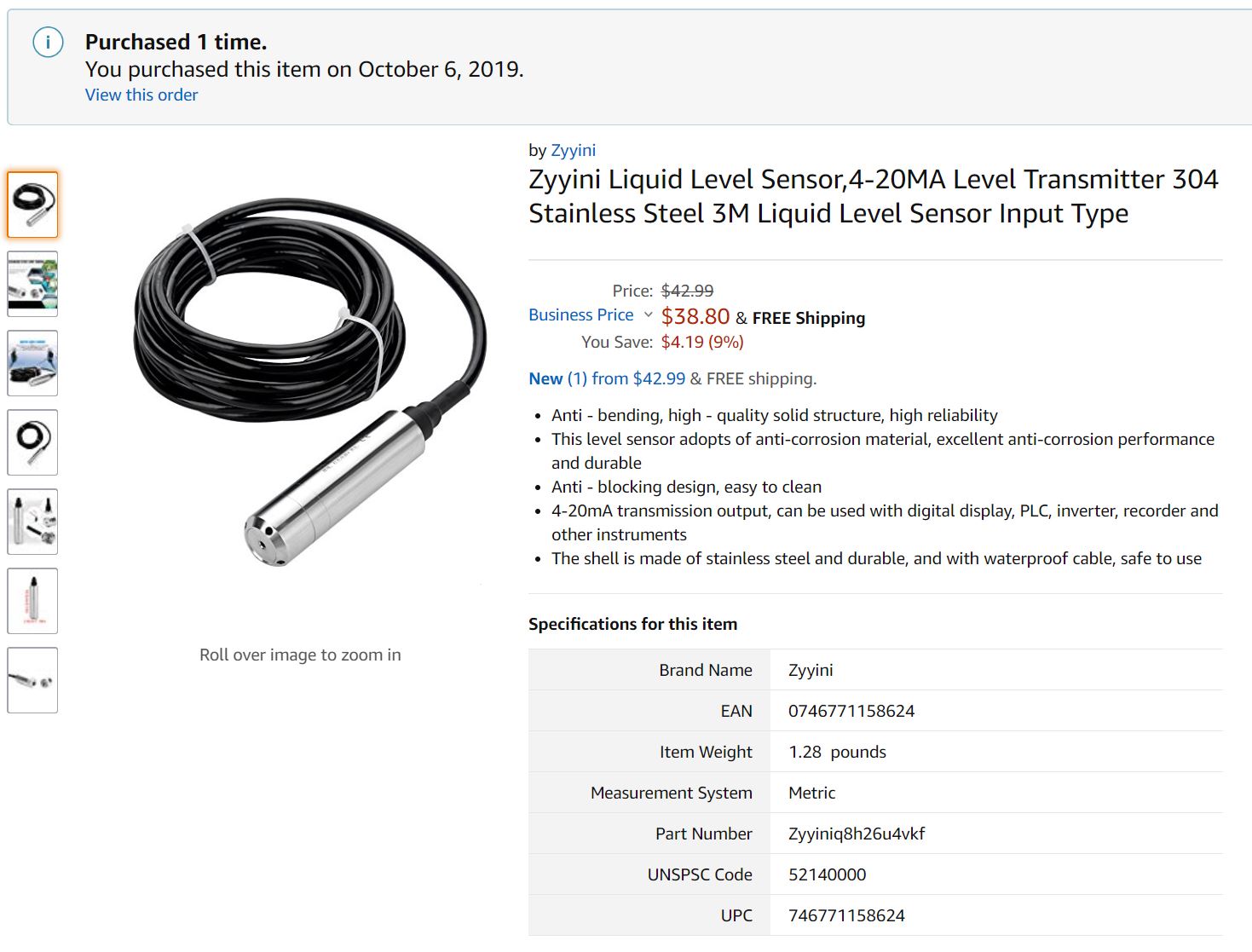
I mentioned earlier that Maretron’s sensors list for $250 each. I wondered if similar sensors could be purchased for less elsewhere. My quick research initially indicated that quality sensors from reputable companies — mostly designed for industrial applications like waste-treatment facilities — were generally more expensive than what Maretron was offering. But, some more digging on Amazon and AliExpress did turn up some very inexpensive options.

All the sensors available on Amazon seemed to be designed for deeper water. The best I could find was a sensor listed as covering 0-3 meters. Since accuracy on all these transducers is listed as a percent of range I figured I would be giving up accuracy by using a sensor for a larger depth range than I needed. But, that’s what I could find on Amazon so that’s what I bought. The purchased sensor was listed as covering 0-3 meters but the one that arrived is labeled for 0-5 meters, likely making it even less accurate.
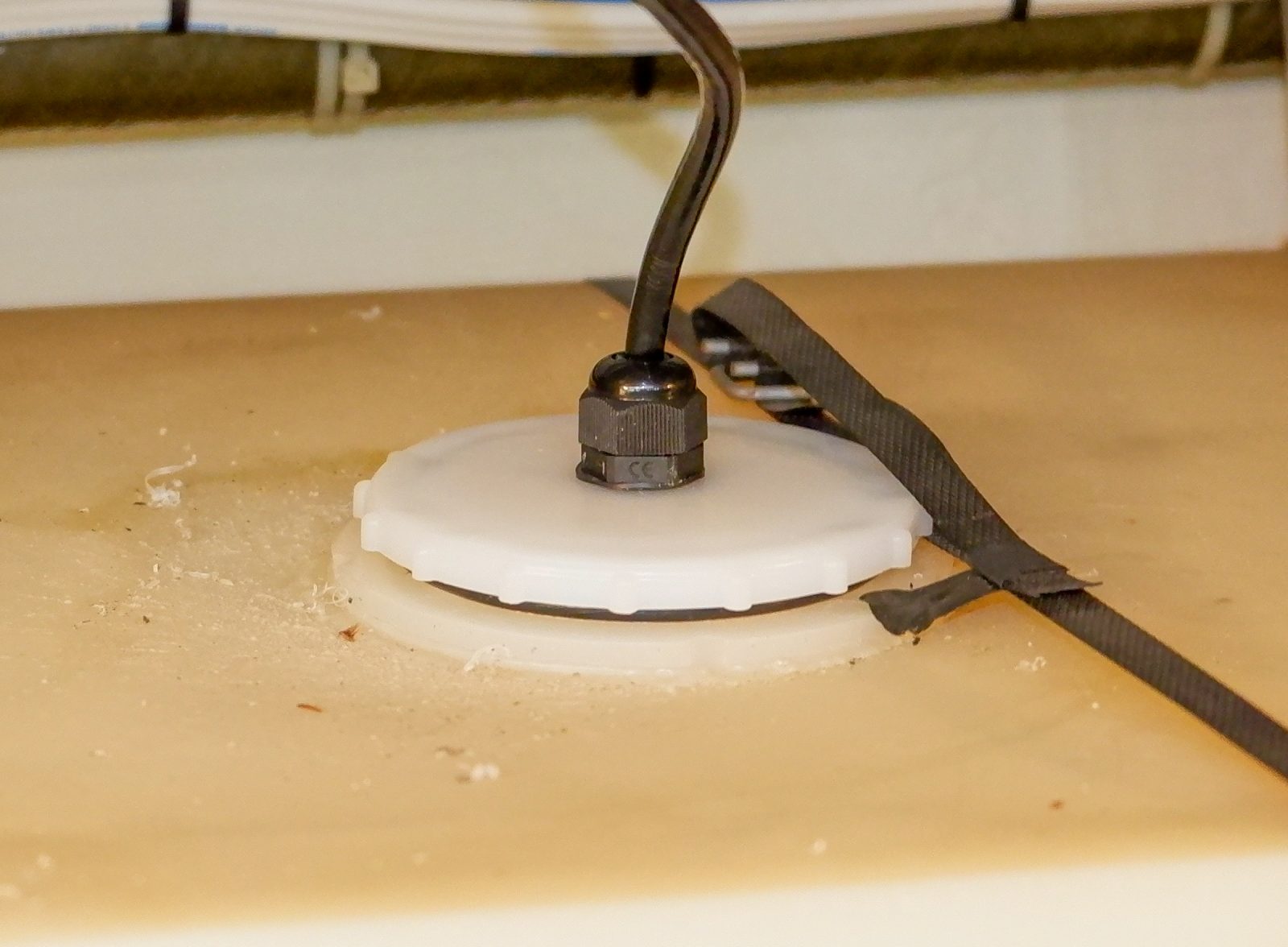
But, I had it in hand and the price was right, so I gave it a try. I selected my port fresh water tank for experimentation. Conveniently that tank is currently unmonitored and has the same 3″ access hatch as my waste tanks.
Because I didn’t know the exact pressure ranges for this sensor I had to do some more experimenting to calibrate. That experimentation primarily consisted of measuring outputs from the sensor when empty and full and then trying values in the calibration table. I estimated the pressure range of this sensor must be about 0-7.1 PSI based on this handy calculator that suggests five meters of water carries a pressure of 7.112 PSI. So far I’ve been perfectly happy with the results I’m getting. A few doses of water run through the tanks thus far suggests this system is far more reliable than the float based sender in my other water tank.
I also have a 0-1 meter sensor on the way from China via AliExpress that I’m hoping might be a little more accurate than the 0-5 I got from Amazon. But, I’m not expecting either the accuracy, reliability, or longevity from these sensors that Maretron’s own sensors deliver. However, at least for me, I’m happy with fresh water measurement being roughly accurate.

Details on one tank displayed on a Maretron DSM250 
A four tank view as displayed on a DSM 250 
A Raymarine MFD displaying tank status 
Tank Status and details displayed by a Yacht Devices WiFi gateway
The last piece of the puzzle is displaying the data. The TankWatch monitors in the heads no longer work — and I’ll need to figure out something to do with that space, even if it’s just a blanking plate, though I don’t find that too troubling. Perhaps the most obvious way to display the data would be on one of Maretron’s DSM line of displays (available in 4.1 and 5.7 inch sizes) or on my MFD. While both of these work I’m looking for the smallest and most cost-effective way to show this information. Ideally I’d love to find an inexpensive 2″ gauge with a single push-button on the front that cycles through the available tanks. The closest I’ve found is from Oceanic Systems, but their gauges are for a single tank and don’t allow cycling through.
If anyone knows of a NMEA 2000 gauge that could easily cycle through the available tanks and display their levels for less than $200, I’m probably in for two. Until then, I have a wealth of ways to display what seems like accurate and reliable tank levels though none of the displays are as easy as I might like.













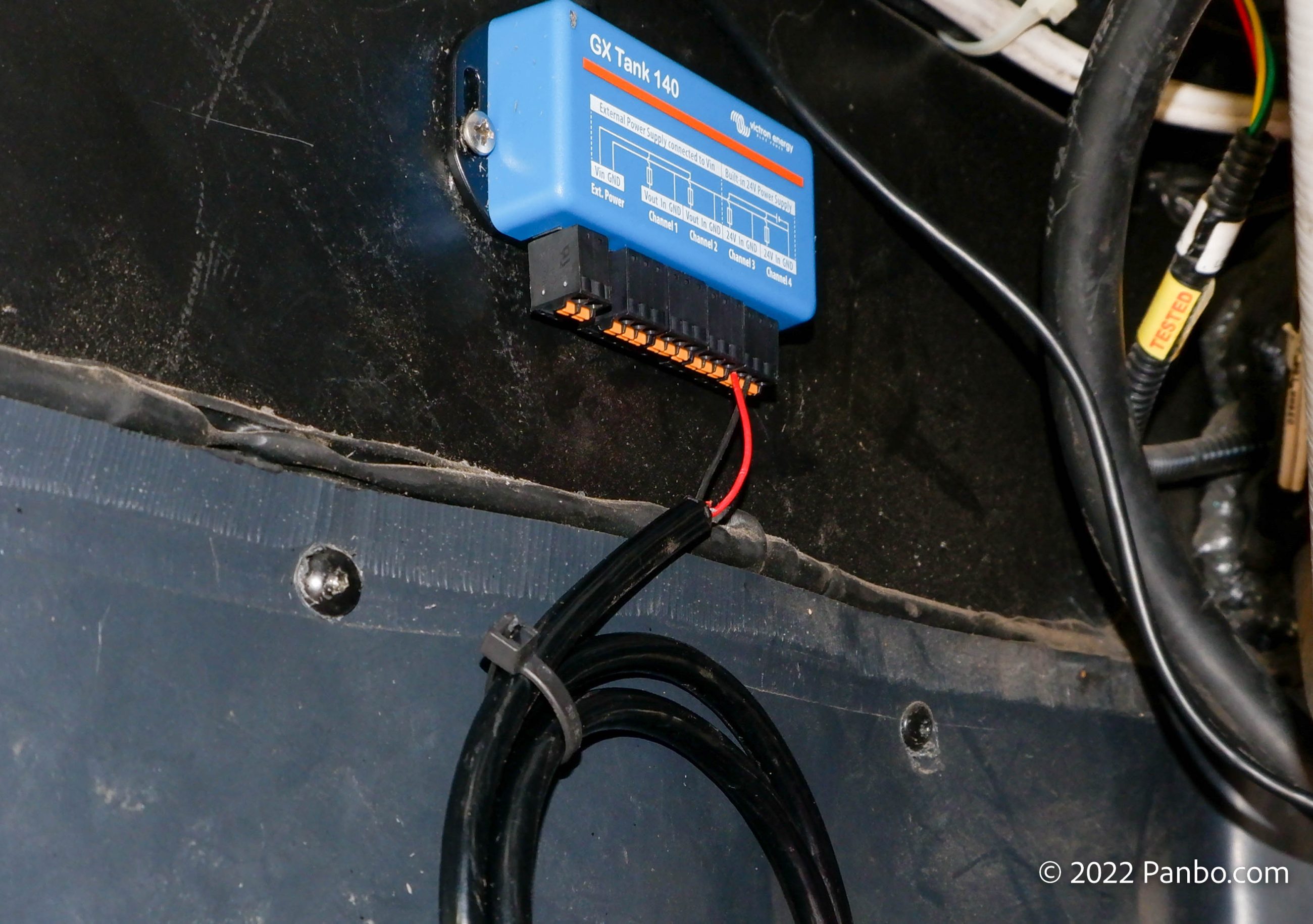

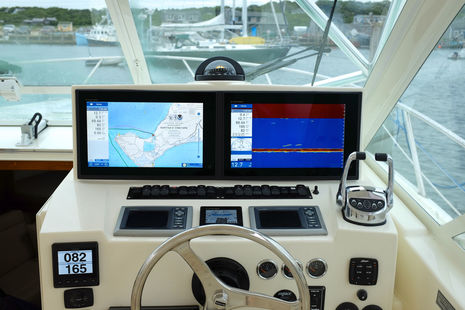
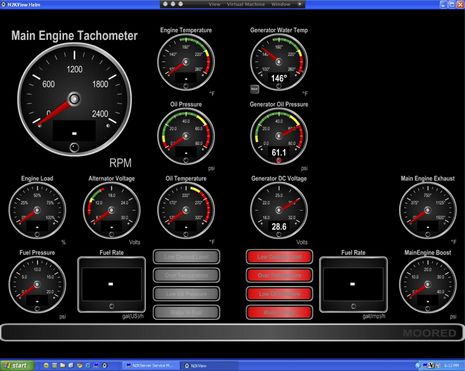







I just replaced two of my Maretron TLM’s with the FPM100 and the 0-1.5 Maretron-branded sensors. Thankfully, I already had SAE openings, so it was a matter of dropping them into the water and diesel tanks, connecting the wires, configuring it on N2KAnalyzer, and done!
Having used the TLMs for a number of years, I can say that the FPM solution is far superior in terms of accuracy, especially when you get near the top/bottom of the tank. The TLMs always stopped reading reliably once you got close to full, and provided wildly erratic readings at inopportune times.
The fuel tank in particular is far more accurate than any system I have, and I’ve been able to verify it through the last couple months of usage.
I haven’t found a good cycling gauge yet. My go-to is any of the DSM series from Maretron, but they are far more than $200!
That’s very interesting Steve. When I started this process I thought for sure Maretron would steer me towards TLMs. I was surprised when they pushed towards the FPM100 but I’ve been quite impressed with how well it works.
Installed Sensatank 2-3 years ago on waste and 2 fresh. Sensors on outside of tanks. Probably have to be plastic tanks. Works very well. Quite inexpensive. Easy install
Marathon needs to make this game easier. Requiring Windows 10, a PC (not a Mac), a USB converter, a special program, etc. is a non starter for me. Making displays and conversion kits to be able to easily replace old units would also be a requirement. Same wire would be nice. In short, there is a long ways to go!
Maretron allows you to configure the FPM100 from any of their displays or gateways. By using the SAE 5 bolt cut-out they make it easier for direct replacement of most senders. I’d love to see them offer a mounting kit with the 3″ plugs as well but that certainly wasn’t a difficult procedure. Maretron also says the sensor wire can be extended by 50 feet, so I think you’d likely be able to use the same wire, though there are a lot of different senders out there and quite a few different wiring patterns so there’s nothing universal for them to be able to offer. I don’t think I can agree that there is such a long way to go. I think Maretron has done the hard work by offering a reliable, easily installed option.
Ben,
I had TLM on my holding tank reading to the DSM-250 and had many conversations with them about the focus tube/air lock? on the bottom of the transponder which was made of aluminum. Seems the nasty contents in the holding tanks happily corroded the tube quickly resulting in heavy build ups of aluminum oxides which caused erratic readings. I’m glad they have come up with a better solution, however I hope that the sensor is truly corrosion proof against the contents. The caustic nature of that offal can even eat stainless steel unless it a special grade of stainless. Hence why holding tanks are not made of Stainless steel. Best to you and the girls!
Joe,
That makes it sound like I might need to do an inspection of the sensor at some point in the future when it’s had some time in the tank. Ugh. I’ll don some gloves in a few months and see what I find.
Thanks!
Ben
I’m a little surprised they recommend the pressure sensor. My experience with another system using pressure sensors were they tended to fail in 2-4 year time span when in Black Tank service. I assume the sensors Maretron spec’s most be a little more rugged.
ben, i really must complain 🙂 – my black tank sender unit has just developed a problem
with low level sensor (pump will not run unless pumpout button held depressed continuously, normally it would run after a press untill it senses “empty”).
Im sure my boat is reading your blog and decided to inconveniently exhibit a senser fault at same time as yours! haha
.. article was VERY pertinent for me .
keep up the great work
Ultrasonic measurement of waste and fuel tanks were a disappointment on my last boat.
I recall the TLM product did display on my Raymarine instruments over N2K. How about the FPM100?
It sure does. You can see a screenshot towards the bottom of the article. The top right image of the gallery of four is a Raymarine Axiom screenshot.
I’ve been troubleshooting an issue with displaying this data on Furuno equipment. It shows up on Ray, Simrad and Garmin, but does not show up on Furuno TZT2 series displays at all. Something about how Maretron is formulating the PGNs is different between the TLM/TLA and the FPM – not sure if it is Maretron or Furuno’s fault yet!
“If anyone knows of a NMEA 2000 gauge that could easily cycle through the available tanks and display their levels for less than $200, I’m probably in for two.”
What about using the yacht devices NMEA display?
Mike,
Good suggestion. I’m actually using one currently and while it does a decent job it’s not as flexible as I’d like. It only supports one fresh water tank for example.
I’d also really like a round, gauge replacement form-factor.
Ben S.
I’ve used a TLM100 with my holding tank for around 5 years and no problems so far. But could be that our tank sees very little solid waste (we are mostly at our dock at night with very convenient and clean bathrooms). I do use an FPM100 for fuel tank level, fuel pressure (post Racor) and engine inlet manifold pressure. Accurate and super easy to setup using a Maretron display.
While gauges look good, setting the Raymarine to show six numeric values provides a lot of visibility into infrequently used values. For example, I put multiple, tanks, battery voltage, water temp, barometer all together in one display, I believe I had set up another page to show depth in big numbers and swapped between that and the tank info, thereby requiring no dedicated displays for tank information.
I am looking to do something similar because my Maretron Ultrasonic really struggles with readings on my waste tank (great on my water tank though). So I plan on buying a FPM100 and one of the transducers. Would you recommend going with the cheaper transducers? Was it worth it?
Also for any of those reading or who is in need of a very good condition Maretrom TLM ultrasonic sensor I would be willing to sell the old one at a much greater discount than list.
Thank you for your post on the senders for the holding tank & so many other useful reviews. On the bosses Offshore 64 I added the TLM By cutting in a new hole and kept the tank watch as a backup to keep the shut-off to the heads functioning. I have had to replace the TLM twice and will now be adding the heads to my FPM system that I used to replace my Tank Sentry system due to the service life & cost of their senders. We have 3 fuel & 2 water tanks that the Tank Sentry system monitor & in 6 years I was about to have to replace the senders for a second time so figured I would give these a try for less than the cost of two of the other senders. Great site thank you again
Is there any risk that these sensors get damaged during a pumpout? I am setting up the FPM to monitor engine boost and came across this article so was thinking why not monitor my black and freshwater tanks as well.
I’ve had mine installed on my black water tank & all other tanks for a year & have had no issues.
Simarine Pico as a monitor?
or Victron Tank 140 with a GX display… https://www.youtube.com/watch?v=xupo4JRw51Y
Hi Ben,
Maybe there is an update how this sensors are performing after 2 years?
Wolgrang,
Thanks for checking in on this. The system continues to perform very well, though I had to make one major change. The Maretron provided — really nice and quite expensive — submersible pressure transducers failed at about the six-month mark. They both failed during pump-outs but not at the same time. I replaced them with roughly $35.00 transducers I got on either Amazon or Ali-Express. These have worked for over a year and a half now with no troubles whatsoever. I sent the Maretron units back to them for them to work with the manufacturer on a failure analysis but haven’t heard back.
But, the TLM100 and the other sensors I’m using for fresh water continue to work flawlessly and I remain very happy with the project overall. Plus, the cheap pressure transducers are cheap enough that even if they only lasted a year or two I would happily replace them and carry on.
-Ben S.
Thank you Ben,
I got a good deal for a brand new FPM100 and wanted to know your experience.
Based on this I will go also for the Amazon pressure transducers.
Currently an UTV (Philippi, more or less comparable with TLM100) is causing problems, have to be cleaned regularly to operate. However this ultrasonic was already much much better as the original tankwatch sensor.
For fresh water ultrasonic is working perfectly in my case too.
Regards, Wolfgang.
I learned the compatibility of a submersible pressure monitor with the FPM100 here in the comments, which took me to the Maretron site.
For my application, sailboat racing, I wish I had a better measurement of how low the tank is. We are frequently keeping it between 1/16 and 1/4 tank to save weight.
A question, how well does it measure when your tank is low? Does that sensor essentially roll around a bit in the tank or do you stabilize it?
I was taking measurements at 1 cm 0.1V running from a 1 cm fluid level.
https://termoregulatory.pl/hydrostatyczne-czujniki-poziomu-cieczy/czujnik-poziomu-cieczy-ps-01-010
I use such strainers against neglect
https://termoregulatory.pl/akstrong/filtr-do-brudnej-wody
The sensor is installed permanently in tanks so that it does not move by heavy sea
Permanent, as in glue? Does the tank need to be drained to install it?
I have photos of how I mount it without glue 😉 I can send it by e-mail.
Hallo Christopher,
kannst du mir Fotos schicken wie du den Sensor ohne Kleben im Tank montiert hast?
raschkeÄTgc-saxonia.de
Danke
Hello Christopher, can you send me photos of how you installed the sensor in the tank without gluing it?
raschkeÄTgc-saxonia.de
Thanks
Speaking of tank level senders, at METS I was tentatively impressed with the new Gobius C, which uses “micro radar” from the top of the tank with claimed “extreme accuracy, steplessly 0-100%” regardless of tank shape”. I particularly like the Bluetooth app access for configuration and verification, but it also offers multiple methods of data output that should work with various wired displays like my boat’s Victron Cerbo. I may try one to replace the currently unreliable Wema sender on my black water tank. More here:
https://gobiusc.com/
I was curious to find out if there is more news to your Gobius C experiment since 2023?